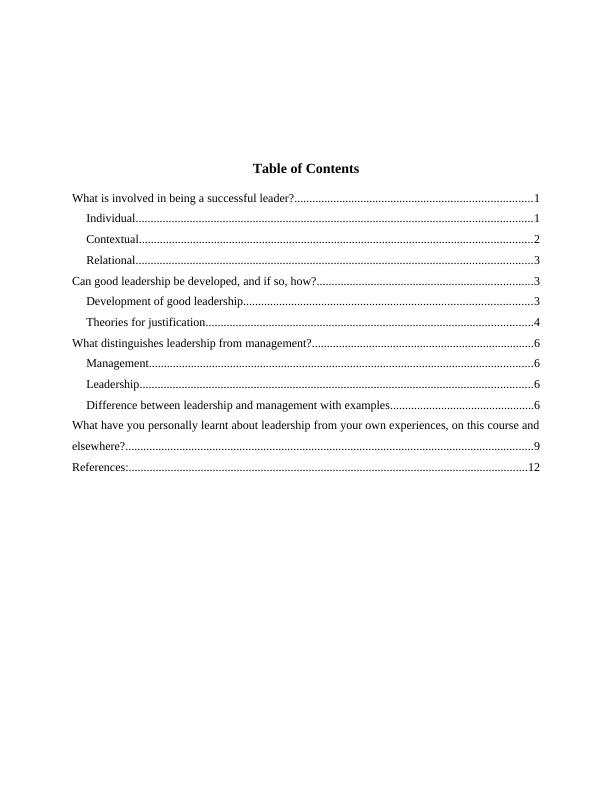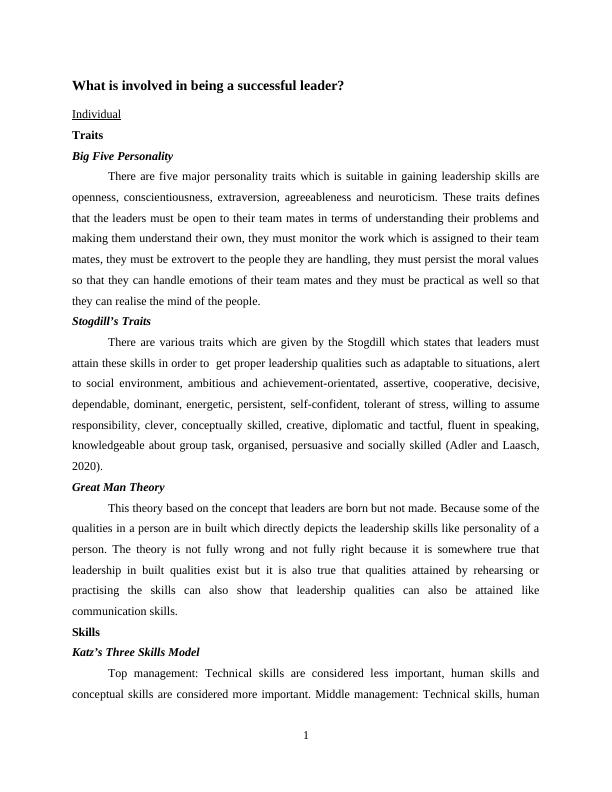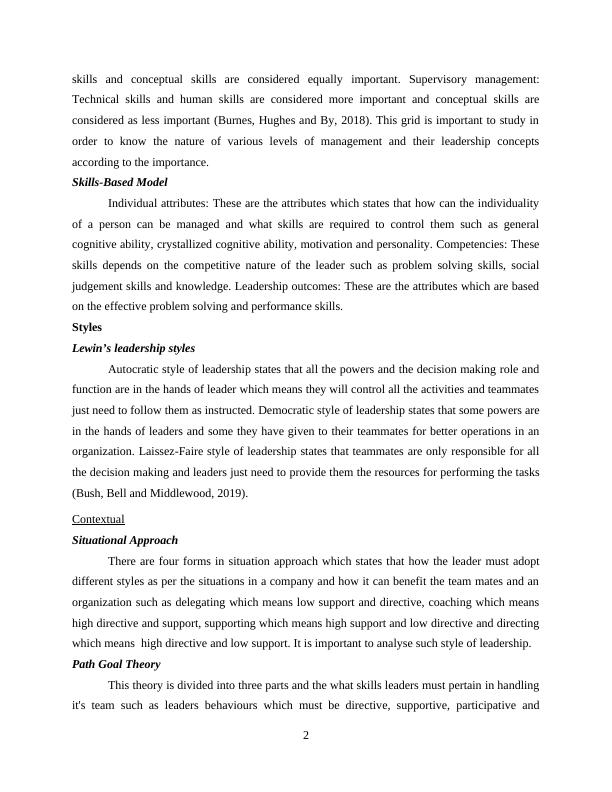Leadership and Management
Added on 2022-12-29
15 Pages4579 Words182 Views
Leadership and
Management
Management

Table of Contents
What is involved in being a successful leader?...............................................................................1
Individual....................................................................................................................................1
Contextual...................................................................................................................................2
Relational....................................................................................................................................3
Can good leadership be developed, and if so, how?........................................................................3
Development of good leadership................................................................................................3
Theories for justification.............................................................................................................4
What distinguishes leadership from management?..........................................................................6
Management................................................................................................................................6
Leadership...................................................................................................................................6
Difference between leadership and management with examples................................................6
What have you personally learnt about leadership from your own experiences, on this course and
elsewhere?........................................................................................................................................9
References:.....................................................................................................................................12
What is involved in being a successful leader?...............................................................................1
Individual....................................................................................................................................1
Contextual...................................................................................................................................2
Relational....................................................................................................................................3
Can good leadership be developed, and if so, how?........................................................................3
Development of good leadership................................................................................................3
Theories for justification.............................................................................................................4
What distinguishes leadership from management?..........................................................................6
Management................................................................................................................................6
Leadership...................................................................................................................................6
Difference between leadership and management with examples................................................6
What have you personally learnt about leadership from your own experiences, on this course and
elsewhere?........................................................................................................................................9
References:.....................................................................................................................................12

What is involved in being a successful leader?
Individual
Traits
Big Five Personality
There are five major personality traits which is suitable in gaining leadership skills are
openness, conscientiousness, extraversion, agreeableness and neuroticism. These traits defines
that the leaders must be open to their team mates in terms of understanding their problems and
making them understand their own, they must monitor the work which is assigned to their team
mates, they must be extrovert to the people they are handling, they must persist the moral values
so that they can handle emotions of their team mates and they must be practical as well so that
they can realise the mind of the people.
Stogdill’s Traits
There are various traits which are given by the Stogdill which states that leaders must
attain these skills in order to get proper leadership qualities such as adaptable to situations, alert
to social environment, ambitious and achievement-orientated, assertive, cooperative, decisive,
dependable, dominant, energetic, persistent, self-confident, tolerant of stress, willing to assume
responsibility, clever, conceptually skilled, creative, diplomatic and tactful, fluent in speaking,
knowledgeable about group task, organised, persuasive and socially skilled (Adler and Laasch,
2020).
Great Man Theory
This theory based on the concept that leaders are born but not made. Because some of the
qualities in a person are in built which directly depicts the leadership skills like personality of a
person. The theory is not fully wrong and not fully right because it is somewhere true that
leadership in built qualities exist but it is also true that qualities attained by rehearsing or
practising the skills can also show that leadership qualities can also be attained like
communication skills.
Skills
Katz’s Three Skills Model
Top management: Technical skills are considered less important, human skills and
conceptual skills are considered more important. Middle management: Technical skills, human
1
Individual
Traits
Big Five Personality
There are five major personality traits which is suitable in gaining leadership skills are
openness, conscientiousness, extraversion, agreeableness and neuroticism. These traits defines
that the leaders must be open to their team mates in terms of understanding their problems and
making them understand their own, they must monitor the work which is assigned to their team
mates, they must be extrovert to the people they are handling, they must persist the moral values
so that they can handle emotions of their team mates and they must be practical as well so that
they can realise the mind of the people.
Stogdill’s Traits
There are various traits which are given by the Stogdill which states that leaders must
attain these skills in order to get proper leadership qualities such as adaptable to situations, alert
to social environment, ambitious and achievement-orientated, assertive, cooperative, decisive,
dependable, dominant, energetic, persistent, self-confident, tolerant of stress, willing to assume
responsibility, clever, conceptually skilled, creative, diplomatic and tactful, fluent in speaking,
knowledgeable about group task, organised, persuasive and socially skilled (Adler and Laasch,
2020).
Great Man Theory
This theory based on the concept that leaders are born but not made. Because some of the
qualities in a person are in built which directly depicts the leadership skills like personality of a
person. The theory is not fully wrong and not fully right because it is somewhere true that
leadership in built qualities exist but it is also true that qualities attained by rehearsing or
practising the skills can also show that leadership qualities can also be attained like
communication skills.
Skills
Katz’s Three Skills Model
Top management: Technical skills are considered less important, human skills and
conceptual skills are considered more important. Middle management: Technical skills, human
1

skills and conceptual skills are considered equally important. Supervisory management:
Technical skills and human skills are considered more important and conceptual skills are
considered as less important (Burnes, Hughes and By, 2018). This grid is important to study in
order to know the nature of various levels of management and their leadership concepts
according to the importance.
Skills-Based Model
Individual attributes: These are the attributes which states that how can the individuality
of a person can be managed and what skills are required to control them such as general
cognitive ability, crystallized cognitive ability, motivation and personality. Competencies: These
skills depends on the competitive nature of the leader such as problem solving skills, social
judgement skills and knowledge. Leadership outcomes: These are the attributes which are based
on the effective problem solving and performance skills.
Styles
Lewin’s leadership styles
Autocratic style of leadership states that all the powers and the decision making role and
function are in the hands of leader which means they will control all the activities and teammates
just need to follow them as instructed. Democratic style of leadership states that some powers are
in the hands of leaders and some they have given to their teammates for better operations in an
organization. Laissez-Faire style of leadership states that teammates are only responsible for all
the decision making and leaders just need to provide them the resources for performing the tasks
(Bush, Bell and Middlewood, 2019).
Contextual
Situational Approach
There are four forms in situation approach which states that how the leader must adopt
different styles as per the situations in a company and how it can benefit the team mates and an
organization such as delegating which means low support and directive, coaching which means
high directive and support, supporting which means high support and low directive and directing
which means high directive and low support. It is important to analyse such style of leadership.
Path Goal Theory
This theory is divided into three parts and the what skills leaders must pertain in handling
it's team such as leaders behaviours which must be directive, supportive, participative and
2
Technical skills and human skills are considered more important and conceptual skills are
considered as less important (Burnes, Hughes and By, 2018). This grid is important to study in
order to know the nature of various levels of management and their leadership concepts
according to the importance.
Skills-Based Model
Individual attributes: These are the attributes which states that how can the individuality
of a person can be managed and what skills are required to control them such as general
cognitive ability, crystallized cognitive ability, motivation and personality. Competencies: These
skills depends on the competitive nature of the leader such as problem solving skills, social
judgement skills and knowledge. Leadership outcomes: These are the attributes which are based
on the effective problem solving and performance skills.
Styles
Lewin’s leadership styles
Autocratic style of leadership states that all the powers and the decision making role and
function are in the hands of leader which means they will control all the activities and teammates
just need to follow them as instructed. Democratic style of leadership states that some powers are
in the hands of leaders and some they have given to their teammates for better operations in an
organization. Laissez-Faire style of leadership states that teammates are only responsible for all
the decision making and leaders just need to provide them the resources for performing the tasks
(Bush, Bell and Middlewood, 2019).
Contextual
Situational Approach
There are four forms in situation approach which states that how the leader must adopt
different styles as per the situations in a company and how it can benefit the team mates and an
organization such as delegating which means low support and directive, coaching which means
high directive and support, supporting which means high support and low directive and directing
which means high directive and low support. It is important to analyse such style of leadership.
Path Goal Theory
This theory is divided into three parts and the what skills leaders must pertain in handling
it's team such as leaders behaviours which must be directive, supportive, participative and
2

End of preview
Want to access all the pages? Upload your documents or become a member.
Related Documents
Leadership And Management Skillslg...
|16
|4495
|157
Analysis of Leadership Capabilitieslg...
|17
|4438
|250
Leadership and Management: Factors, Development, and Role in Businesslg...
|14
|3950
|468
Guide to Leadership and Management: Factors, Development, and Differenceslg...
|13
|3838
|439
Leadership and Management: Understanding the Traits and Approacheslg...
|11
|3442
|433
Leadership and Management Assignment - Solutionlg...
|12
|4210
|472